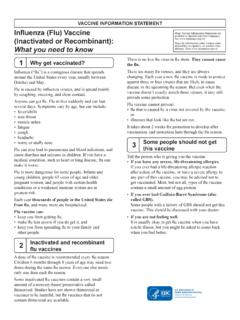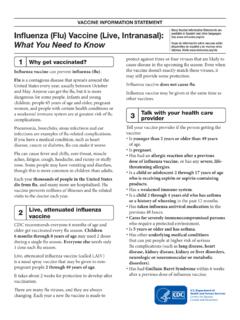Transcription of Recommended composition of influenza virus vaccines for ...
1 Recommended composition of influenza virus vaccines for use in the 2021- 2022 northern hemisphere influenza season February 2021. WHO convenes technical consultations 1 in February and September each year to recommend viruses for inclusion in influenza vaccines 2 for the northern and southern hemisphere influenza seasons, respectively. This recommendation relates to the influenza vaccines for use in the northern hemisphere 2021-2022 influenza season. A recommendation will be made in September 2021 relating to vaccines that will be used for the southern hemisphere 2022 influenza season. For countries in tropical and subtropical regions, WHO recommendations for influenza vaccine composition (northern hemisphere or southern hemisphere) are available on the WHO Global influenza Programme website 3.
2 Seasonal influenza activity Public health and laboratory responses to the COVID-19 pandemic, caused by the coronavirus SARS- CoV-2, initially led to reduced influenza surveillance and/or reporting activities in many countries, which have been improving. Additionally, COVID-19 mitigation strategies including restrictions on travel, use of respiratory protection, and social-distancing measures in most countries have contributed to decreased influenza activity. Overall, record-low levels of influenza detections were reported and fewer viruses were available for characterization during the September 2020 to January 2021 time- period than in previous years. Between September 2020 and January 2021, influenza A(H1N1)pdm09, A(H3N2) and influenza B.
3 Viruses circulated in very low numbers and the relative proportions of the viruses circulating varied among reporting countries. Globally, since September 2020, influenza activity was mostly reported from countries in the tropics and subtropics and some countries in the temperate zone of the northern hemisphere. Overall, the percent positivity for influenza viruses in all specimens tested during this period was less than In contrast, the average percent positivity during the same reporting period of the three previous seasons (2017-2020) was 17%. In the temperate zone of the northern hemisphere, influenza activity remained far lower than usual for this time of year, with very low-level detections of influenza A and B viruses in reporting countries.
4 In Europe, there were only sporadic detections of influenza A or B viruses. By comparison with previous years, there was a 20% reduction in the number of specimens tested, but a 99% reduction in influenza positive samples. In North America, the percentage of tests that were positive for influenza virus was very low, despite testing at usual or increased levels. The majority of detections were influenza B, and where subtyping was performed, both A(H1N1)pdm09 and A(H3N2) viruses were reported. In Asia, influenza activity was also lower than usual for this time of year. influenza A and B. viruses were detected in most reporting countries with a predominance of influenza B viruses in Afghanistan, China, the Islamic Republic of Iran, and Saudi Arabia.
5 In the Democratic People's Republic of Korea only influenza A viruses were reported, with A(H1N1)pdm09 predominating. Japan reported a slight increase in influenza activity in week 5 of 2021, with a small outbreak of A(H3N2). 1. 2. Description of the process of influenza vaccine virus selection and development available at: 3. influenza in the tropics and sub-tropics: 26 February 2021 Page 1 of 10. influenza activity in tropical and subtropical countries was generally very low, with co-circulation of influenza A(H1N1)pdm09, A(H3N2) and influenza B viruses. In tropical countries of Africa, influenza activity was reported mainly from countries in East and West Africa. In East Africa, small numbers of influenza A(H3N2) and influenza B viruses were reported, with a predominance of influenza B in Kenya.
6 In West Africa, the countries of Burkina Faso, C te d'Ivoire, Mali and Mauritania reported a predominance of influenza A(H3N2), followed by influenza B, and a few detections of A(H1N1)pdm09 viruses. influenza A(H3N2) and influenza B viruses were reported in equal proportions in Ghana and Senegal, while influenza B viruses predominated in Guinea and Sierra Leone. A(H1N1)pdm09 viruses were predominant in Niger and Togo. In tropical countries of Asia, most influenza detections were reported from Bangladesh, Cambodia, India, Lao People's Democratic Republic, Thailand and Viet Nam; influenza A(H3N2) was predominant with a few detections of influenza B and A(H1N1)pdm09 viruses. In the tropical countries of the Caribbean and Central America, influenza activity was also very low; most detections were reported by Haiti, where the majority were influenza B viruses.
7 In the temperate zones of the southern hemisphere, influenza activity was much lower than usual inter-seasonal levels with sporadic detections in some countries. Over 59,000 specimens were tested for influenza viruses during this period, and only 11 specimens, originating from Argentina and Chile, were positive for influenza A or B viruses. Among reporting countries in Oceania and Southern Africa, influenza viruses were not detected despite testing. influenza A. Globally, from September 2020 through January 2021, overall influenza A virus detections were in the minority during this period compared to influenza B virus detections. However, from September to November 2020, influenza A virus detections predominated in some countries.
8 In most countries, areas and territories reporting influenza A viruses, both A(H1N1)pdm09 and A(H3N2) subtypes were detected. influenza A(H3N2) viruses were detected in higher proportions than influenza A(H1N1)pdm09 in some countries in Africa (Burkina Faso, C te d'Ivoire, Ghana, Mali, Mauritania and Senegal) and Asia (Bangladesh, Cambodia, India, Lao People's Democratic Republic, Thailand and Viet Nam). influenza A(H1N1)pdm09 viruses predominated in other countries in Africa (Egypt, Niger and Togo), Asia (the Democratic People's Republic of Korea) and Europe (Ukraine). influenza B. Globally, more influenza B viruses were detected than influenza A viruses during this period and influenza B viruses have predominated since November 2020.
9 Of the influenza B viruses where lineage was determined, nearly all were the B/Victoria/2/87 lineage and the majority were reported from Afghanistan, China, C te d'Ivoire, Ghana, Guinea, Haiti and Senegal. B/Yamagata/16/88 lineage viruses were reported in very low numbers by a few countries (Afghanistan, Sweden and the United States of America). 26 February 2021 Page 2 of 10. Detailed information of the extent of seasonal influenza activity by country and type/subtype of viruses worldwide is available on the WHO website: Antigenic and genetic characteristics of recent seasonal influenza viruses, human serology and antiviral susceptibility influenza A(H1N1)pdm09 viruses A(H1N1)pdm09 viruses that have circulated since February 2020 have haemagglutinin (HA) genes that belong to phylogenetic clade , with the vast majority clustering within subclade characterized by HA1 amino acid substitutions N129D, T185I and N260D, taking the HA sequence of A/Idaho/07/2018 as the reference (a parental clade virus closely related to the former vaccine virus A/Brisbane/02/2018).
10 Subclade (5A) has further diverged into two major subclades: 5A-187A (also called,5A+187A), characterized by D187A and Q189E (located in HA antigenic site Sb), and 5A-156K (also called 5A+156K) defined by N156K (located in antigenic site Sa), K130N, L161I, V250A and E506D (E179D in HA2). Viruses belonging to both groups have co-circulated during 2020. While the global frequency of 5A-156K viruses had rapidly increased during the first half of 2020 until reaching similar proportions as 5A-187A, the majority of viruses characterized since September 2020 belong to group 5A-187A. The antigenic characteristics of A(H1N1)pdm09 viruses were assessed with post-infection ferret antisera in haemagglutination inhibition (HI) assays. However, antigenic analysis of viruses with collection dates after August 2020 has been very limited due to the small number of viruses available.















